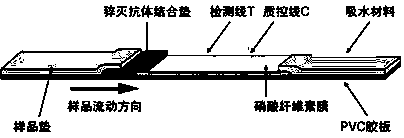Fluorescence quantitative detection card for aflatoxin B1 and application thereof
A technology for fluorescent quantitative detection and aflatoxin, which is applied in the direction of measuring devices, instruments, scientific instruments, etc., can solve the problems of high technical level requirements, expensive equipment, cumbersome processing, etc., avoid separation and washing steps, and be easy to operate and portable strong effect
- Summary
- Abstract
- Description
- Claims
- Application Information
AI Technical Summary
Problems solved by technology
Method used
Image
Examples
Embodiment 1
[0013] Example 1: Preparation of Aspergillus flavus B1 fluorescence quantitative detection card
[0014] 1. Preparation of raw materials for Aspergillus flavus B1 fluorescence quantitative detection card
[0015] 1. Synthesis of Aspergillus flavus B1 artificial antigen
[0016] Aspergillus flavus B1 is a small molecule substance with only immunoreactivity, no immunogenicity, and cannot induce an immune response in the body. The two drugs are coupled to the carrier protein by the glutaraldehyde method or the diazotization method to obtain the two drugs The carrier protein conjugate is immunogenic.
[0017] 2. Preparation of Aspergillus flavus B1 monoclonal antibody
[0018] (1) Animal immunization program
[0019] BALB / c mice were used as immunized animals, Aspergillus flavus B1-carrier protein was used as immunogen, and the immunization dose was 50-100μg / mouse. In the first immunization, the immunogen and the same amount of Freund's complete adjuvant are mixed to make an emulsifier, an...
Embodiment 2
[0039] Example 2: Application of Aspergillus flavus B1 fluorescence quantitative detection card
[0040] 1. Sample preparation
[0041] 1. Blank sample: grain, feed
[0042] Grind the sample to be tested into powder (pass through a 20-mesh sieve); weigh 1.00 ± 0.05 g of the crushed sample into a 10 mL centrifuge tube; add 4 mL sample extract (sample extract: 70 mL methanol and 30 mL deionized Water, mix well), vortex vigorously for 5 min, 4000 g, and centrifuge for 5 min; take 50 μL of the processed sample supernatant and add it to 1 mL of sample diluent (0.01M PBS) and mix.
[0043] 2. Add sample: Add aflatoxin B1 standard to the blank sample to the required concentration.
[0044] 2. Determination of the lowest detection limit
[0045] Take 20 blank grain and feed samples, use the aflatoxin B1 fluorescence quantitative detection card for detection, calculate the average value, and add 3 times the standard deviation, which is the lowest detection limit.
[0046] Table 1 Statistical tabl...
PUM
 Login to View More
Login to View More Abstract
Description
Claims
Application Information
 Login to View More
Login to View More - R&D
- Intellectual Property
- Life Sciences
- Materials
- Tech Scout
- Unparalleled Data Quality
- Higher Quality Content
- 60% Fewer Hallucinations
Browse by: Latest US Patents, China's latest patents, Technical Efficacy Thesaurus, Application Domain, Technology Topic, Popular Technical Reports.
© 2025 PatSnap. All rights reserved.Legal|Privacy policy|Modern Slavery Act Transparency Statement|Sitemap|About US| Contact US: help@patsnap.com



